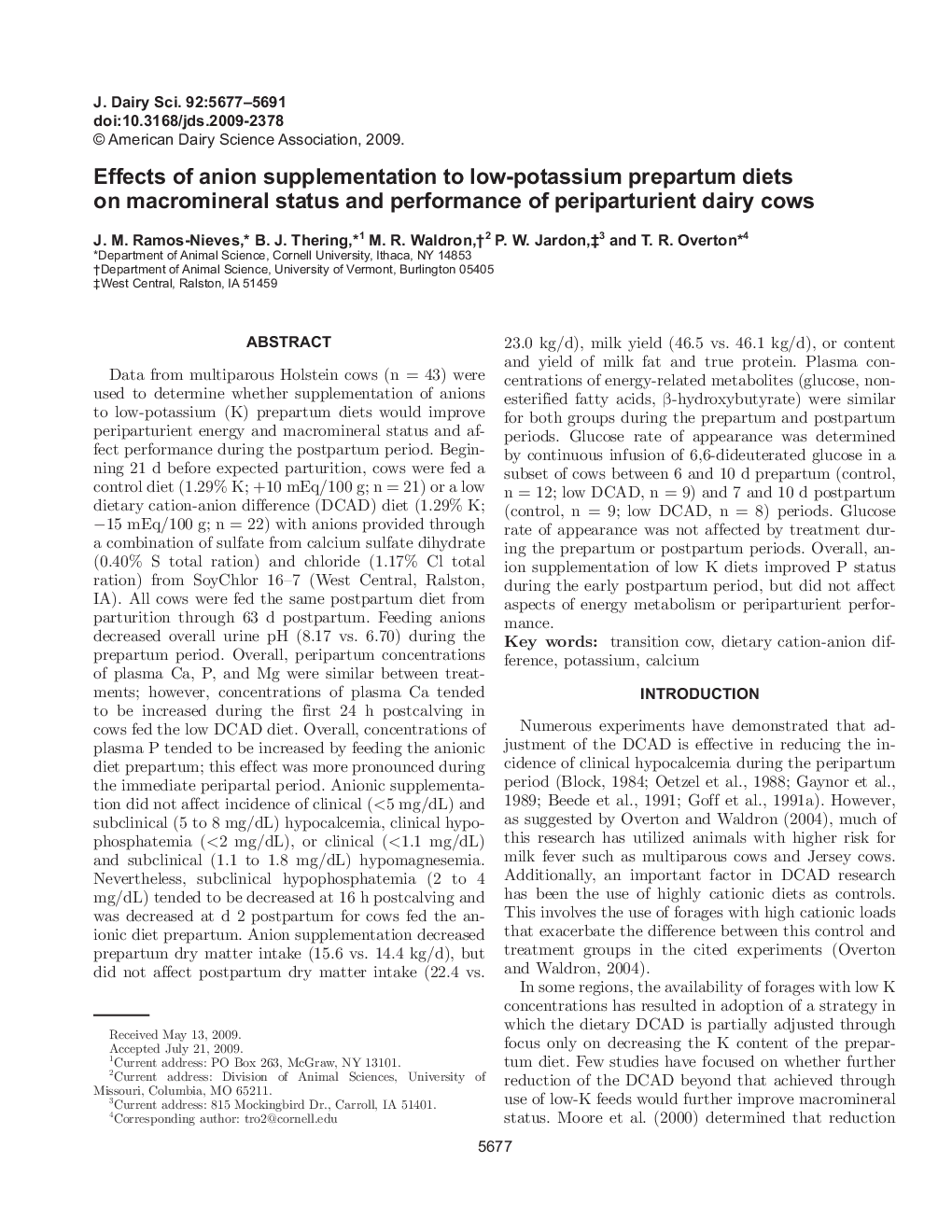| کد مقاله | کد نشریه | سال انتشار | مقاله انگلیسی | نسخه تمام متن |
|---|---|---|---|---|
| 2439130 | 1108087 | 2009 | 15 صفحه PDF | دانلود رایگان |
عنوان انگلیسی مقاله ISI
Effects of anion supplementation to low-potassium prepartum diets on macromineral status and performance of periparturient dairy cows
دانلود مقاله + سفارش ترجمه
دانلود مقاله ISI انگلیسی
رایگان برای ایرانیان
کلمات کلیدی
موضوعات مرتبط
علوم زیستی و بیوفناوری
علوم کشاورزی و بیولوژیک
علوم دامی و جانورشناسی
پیش نمایش صفحه اول مقاله

چکیده انگلیسی
Data from multiparous Holstein cows (n = 43) were used to determine whether supplementation of anions to low-potassium (K) prepartum diets would improve periparturient energy and macromineral status and affect performance during the postpartum period. Beginning 21 d before expected parturition, cows were fed a control diet (1.29% K; +10 mEq/100 g; n = 21) or a low dietary cation-anion difference (DCAD) diet (1.29% K; â15 mEq/100 g; n = 22) with anions provided through a combination of sulfate from calcium sulfate dihydrate (0.40% S total ration) and chloride (1.17% Cl total ration) from SoyChlor 16-7 (West Central, Ralston, IA). All cows were fed the same postpartum diet from parturition through 63 d postpartum. Feeding anions decreased overall urine pH (8.17 vs. 6.70) during the prepartum period. Overall, peripartum concentrations of plasma Ca, P, and Mg were similar between treatments; however, concentrations of plasma Ca tended to be increased during the first 24 h postcalving in cows fed the low DCAD diet. Overall, concentrations of plasma P tended to be increased by feeding the anionic diet prepartum; this effect was more pronounced during the immediate peripartal period. Anionic supplementation did not affect incidence of clinical (<5 mg/dL) and subclinical (5 to 8 mg/dL) hypocalcemia, clinical hypophosphatemia (<2 mg/dL), or clinical (<1.1 mg/dL) and subclinical (1.1 to 1.8 mg/dL) hypomagnesemia. Nevertheless, subclinical hypophosphatemia (2 to 4 mg/dL) tended to be decreased at 16 h postcalving and was decreased at d 2 postpartum for cows fed the anionic diet prepartum. Anion supplementation decreased prepartum dry matter intake (15.6 vs. 14.4 kg/d), but did not affect postpartum dry matter intake (22.4 vs. 23.0 kg/d), milk yield (46.5 vs. 46.1 kg/d), or content and yield of milk fat and true protein. Plasma concentrations of energy-related metabolites (glucose, nonesterified fatty acids, β-hydroxybutyrate) were similar for both groups during the prepartum and postpartum periods. Glucose rate of appearance was determined by continuous infusion of 6,6-dideuterated glucose in a subset of cows between 6 and 10 d prepartum (control, n = 12; low DCAD, n = 9) and 7 and 10 d postpartum (control, n = 9; low DCAD, n = 8) periods. Glucose rate of appearance was not affected by treatment during the prepartum or postpartum periods. Overall, anion supplementation of low K diets improved P status during the early postpartum period, but did not affect aspects of energy metabolism or periparturient performance.
ناشر
Database: Elsevier - ScienceDirect (ساینس دایرکت)
Journal: Journal of Dairy Science - Volume 92, Issue 11, November 2009, Pages 5677-5691
Journal: Journal of Dairy Science - Volume 92, Issue 11, November 2009, Pages 5677-5691
نویسندگان
J.M. Ramos-Nieves, B.J. Thering, M.R. Waldron, P.W. Jardon, T.R. Overton,